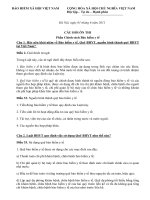21 lecture presentation 0
Bạn đang xem bản rút gọn của tài liệu. Xem và tải ngay bản đầy đủ của tài liệu tại đây (3.41 MB, 94 trang )
Chapter
21
Genomes and Their Evolution
PowerPoint® Lecture Presentations for
Biology
Eighth Edition
Neil Campbell and Jane Reece
Lectures by Chris Romero, updated by Erin Barley with contributions from Joan Sharp
Copyright © 2008 Pearson Education, Inc., publishing as Pearson Benjamin Cummings
Overview: Reading the Leaves from the Tree of
Life
• Complete genome sequences exist for a
human, chimpanzee, E. coli, brewer’s yeast,
nematode, fruit fly, house mouse, rhesus
macaque, and other organisms
• Comparisons of genomes among organisms
provide information about the evolutionary
history of genes and taxonomic groups
Copyright © 2008 Pearson Education Inc., publishing as Pearson Benjamin Cummings
• Genomics is the study of whole sets of genes
and their interactions
• Bioinformatics is the application of
computational methods to the storage and
analysis of biological data
Copyright © 2008 Pearson Education Inc., publishing as Pearson Benjamin Cummings
Fig. 21-1
Concept 21.1: New approaches have accelerated
the pace of genome sequencing
• The most ambitious mapping project to date
has been the sequencing of the human
genome
• Officially begun as the Human Genome
Project in 1990, the sequencing was largely
completed by 2003
• The project had three stages:
– Genetic (or linkage) mapping
– Physical mapping
– DNA sequencing
Copyright © 2008 Pearson Education Inc., publishing as Pearson Benjamin Cummings
Three-Stage Approach to Genome
Sequencing
• A linkage map (genetic map) maps the
location of several thousand genetic markers
on each chromosome
• A genetic marker is a gene or other identifiable
DNA sequence
• Recombination frequencies are used to
determine the order and relative distances
between genetic markers
Copyright © 2008 Pearson Education Inc., publishing as Pearson Benjamin Cummings
Fig. 21-2-1
Cytogenetic map
Genes located
by FISH
Chromosome
bands
Fig. 21-2-2
Chromosome
bands
Cytogenetic map
Genes located
by FISH
1
Linkage mapping
Genetic
markers
Fig. 21-2-3
Chromosome
bands
Cytogenetic map
Genes located
by FISH
1
Linkage mapping
Genetic
markers
2
Physical mapping
Overlapping
fragments
Fig. 21-2-4
Chromosome
bands
Cytogenetic map
Genes located
by FISH
1
Linkage mapping
Genetic
markers
2
Physical mapping
Overlapping
fragments
3
DNA sequencing
• A physical map expresses the distance
between genetic markers, usually as the
number of base pairs along the DNA
• It is constructed by cutting a DNA molecule into
many short fragments and arranging them in
order by identifying overlaps
Copyright © 2008 Pearson Education Inc., publishing as Pearson Benjamin Cummings
• Sequencing machines are used to determine
the complete nucleotide sequence of each
chromosome
• A complete haploid set of human
chromosomes consists of 3.2 billion base pairs
Copyright © 2008 Pearson Education Inc., publishing as Pearson Benjamin Cummings
Whole-Genome Shotgun Approach to Genome
Sequencing
• The whole-genome shotgun approach was
developed by J. Craig Venter in 1992
• This approach skips genetic and physical
mapping and sequences random DNA
fragments directly
• Powerful computer programs are used to order
fragments into a continuous sequence
Copyright © 2008 Pearson Education Inc., publishing as Pearson Benjamin Cummings
Fig. 21-3-1
1 Cut the DNA
into overlapping
fragments short enough
for sequencing
2 Clone the fragments
in plasmid or phage
vectors.
Fig. 21-3-2
1 Cut the DNA
into overlapping
fragments short enough
for sequencing
2 Clone the fragments
in plasmid or phage
vectors.
3 Sequence each
fragment.
Fig. 21-3-3
1 Cut the DNA
into overlapping
fragments short enough
for sequencing
2 Clone the fragments
in plasmid or phage
vectors.
3 Sequence each
fragment.
4 Order the
sequences into
one overall
sequence
with computer
software.
• Both the three-stage process and the wholegenome shotgun approach were used for the
Human Genome Project and for genome
sequencing of other organisms
• At first many scientists were skeptical about
the whole-genome shotgun approach, but it is
now widely used as the sequencing method of
choice
• A hybrid of the two approaches may be the
most useful in the long run
Copyright © 2008 Pearson Education Inc., publishing as Pearson Benjamin Cummings
Concept 21.2 Scientists use bioinformatics to
analyze genomes and their functions
• The Human Genome Project established
databases and refined analytical software to
make data available on the Internet
• This has accelerated progress in DNA
sequence analysis
Copyright © 2008 Pearson Education Inc., publishing as Pearson Benjamin Cummings
Centralized Resources for Analyzing Genome
Sequences
• Bioinformatics resources are provided by a
number of sources:
– National Library of Medicine and the National
Institutes of Health (NIH) created the National
Center for Biotechnology Information (NCBI)
– European Molecular Biology Laboratory
– DNA Data Bank of Japan
Copyright © 2008 Pearson Education Inc., publishing as Pearson Benjamin Cummings
• Genbank, the NCBI database of sequences,
doubles its data approximately every 18 months
• Software is available that allows online visitors to
search Genbank for matches to:
– A specific DNA sequence
– A predicted protein sequence
– Common stretches of amino acids in a protein
• The NCBI website also provides 3-D views of all
protein structures that have been determined
Copyright © 2008 Pearson Education Inc., publishing as Pearson Benjamin Cummings
Fig. 21-4
Identifying Protein-Coding Genes Within DNA
Sequences
• Computer analysis of genome sequences
helps identify sequences likely to encode
proteins
• Comparison of sequences of “new” genes with
those of known genes in other species may
help identify new genes
Copyright © 2008 Pearson Education Inc., publishing as Pearson Benjamin Cummings
Understanding Genes and Their Products at the
Systems Level
• Proteomics is the systematic study of all
proteins encoded by a genome
• Proteins, not genes, carry out most of the
activities of the cell
Copyright © 2008 Pearson Education Inc., publishing as Pearson Benjamin Cummings
How Systems Are Studied: An
Example
• A systems biology approach can be applied to
define gene circuits and protein interaction
networks
• Researchers working on Drosophila used
powerful computers and software to predict
4,700 protein products that participated in
4,000 interactions
• The systems biology approach is possible
because of advances in bioinformatics
Copyright © 2008 Pearson Education Inc., publishing as Pearson Benjamin Cummings
Fig. 21-5
Proteins









